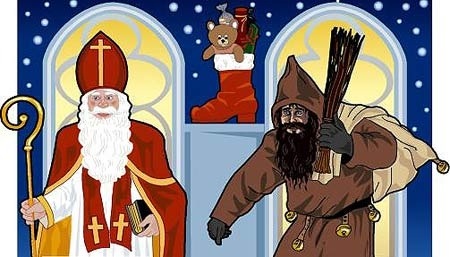Tags
custom, farmhand, germany, knave, knecht, krampus, nazi, rupert, ruprecht, saint nicholas, servant, tradition, zwarte piet
In the folklore of Germany, Knecht Ruprecht (Farmhand, Knave or Servant Rupert) is a companion of Saint Nicholas, but often he traveled alone. He had an unkept appearance: a long beard, clothing made of burlap and fur, and a soot-covered, menacing face. Knecht Ruprecht arrived during the Christmas season carrying a long staff (aka beating stick) and a bag of ashes. Children would be summoned to perform tricks to prove that they were good children deserving treats. Those who performed badly would be beaten, and those who were bad throughout the year were put into Ruprecht’s sack and tossed in a river.
In the centuries before World War I, Knecht Ruprecht might ask children whether they pray. Yes = fruit, nuts, candy and gingerbread. No = a beating with Ruprecht’s bag of ashes. He may give naughty children a stick in their shoes for their parents to beat them with. That’s truly the gift that keeps on giving.
The Nazi campaign to remove religion from Christmas favored Knecht Ruprecht over Santa Claus since they believed Ruprecht was a form of the pagan god, Odin (I told you yesterday, more on him later. Gees, stop pressuring me!). I did a bit of research into how Christmas was celebrated under Nazi rule, but it’s a bit too depressing to even write about here. It’s pretty much as you’d expect; fortunately their rule was short enough that most German traditions easily returned at the the end of World War II.
Knecht Ruprecht and Krampus have crossed lines several times over history, occasionally leaving Ruprecht with goat-like devil features but lightening up our pal Krampus. Ruprecht has sometimes taken on characteristics of Zwarte Piet, such as his kindness or (gulp) blackface. While it can get difficult to tell the characters apart, Knecht Ruprecht is generally seen as a bit grumpy where Piet is a comic and Krampus is… Well, Krampus. image source
image source

So I’m guessing that, since Ruprecht likely only had one sack, you could be pretty bad throughout the year as long as there was just that one kid who was a little more bad. Kinda like being chased by a lion, you don’t have to be the quickest, you only have to be faster than one other runner!